Anytime anyone asks me for digital marketing tips for small businesses, the first thing I always highlight is to know your customers. If there’s one thing in marketing that’s remained true, it’s that. Digital marketing isn’t so different from traditional marketing—it’s still all about centering your customers’ preferences and addressing their needs and pain points. It’s only the mediums for reaching them that have evolved.
Not to worry. As you’ll soon find, the online world has opened up a wealth of opportunities for marketing your small business. Sure, it can get a little overwhelming, but that’s why I’ve compiled a list of 29 tips I’ve learned from marketing startups and small businesses in the digital age. (And no, it’s not just about creating your Facebook page and calling it a day.) From social to email, SEO to chatbots, here are the best ways to leverage digital channels to market your business.
1. Research Your Audience and Create Customer Personas
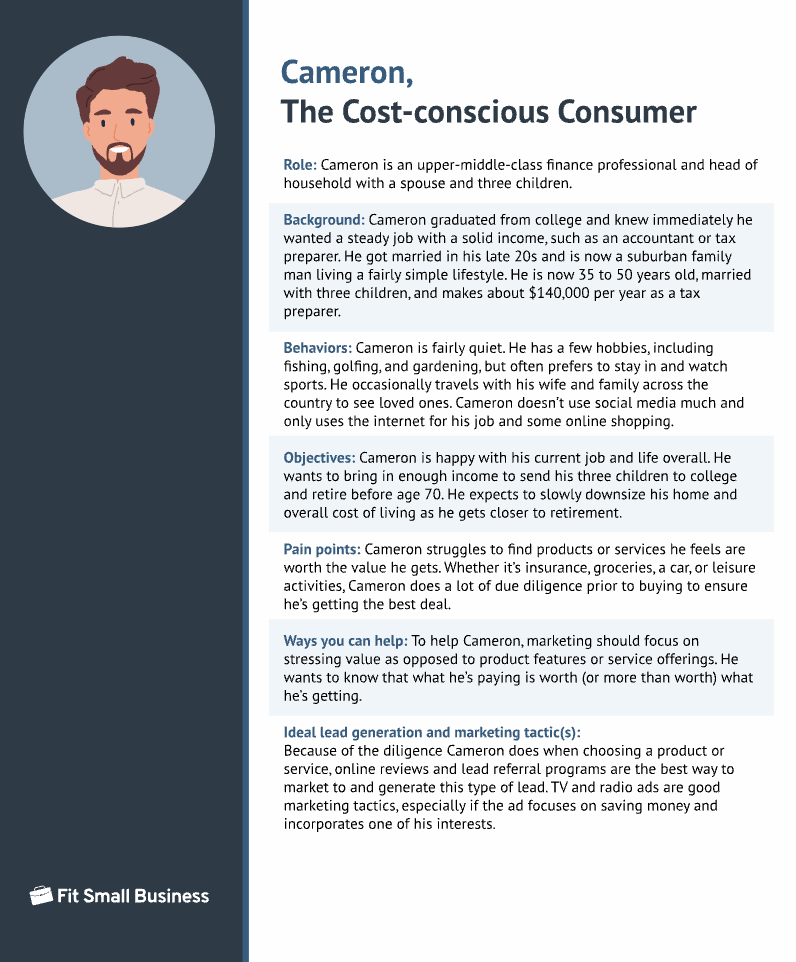
Customer personas like these can help you craft more effective marketing strategies and messages.
As I’ve mentioned, effective marketing is primarily about understanding your audience’s preferences, pain points, and problems, and then providing them with a solution. This means doing lots of research about them is essential, from their basic demographics to their interests, problems, and even their online habits and buying behavior, like what social platforms they spend the most time on.
Doing this will give you a clear and well-rounded idea of who your target audience members are as people, which will help you reach out to them more effectively and craft more meaningful marketing messages. It also helps to create customer personas like the example above as a reference.
2. Create a Good Business Website
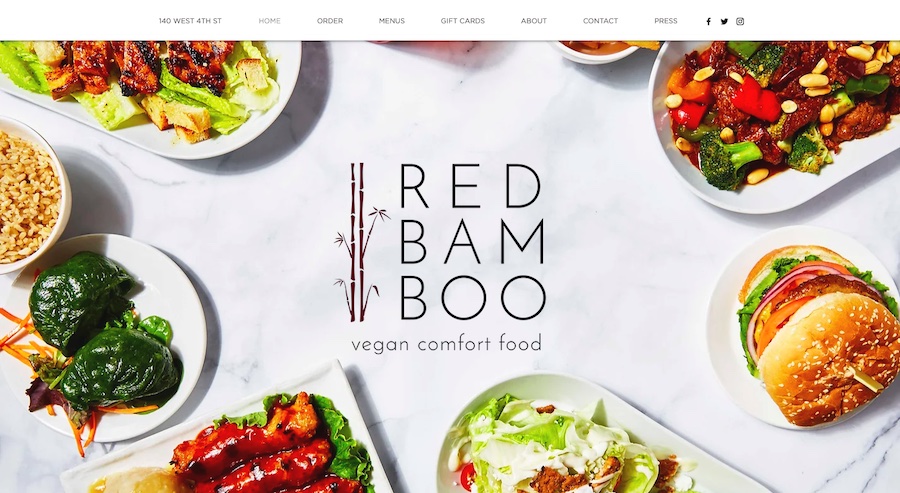
Beginner-friendly website builders like Wix and Squarespace have ready-to-use templates you can easily customize, like the one above. (Source: Red Bamboo)
If you plan to do digital marketing, you need to build a business website. Besides making your brand more discoverable online, a website also boosts your credibility, allows more opportunities to reach customers, and even generates more sales.
The best part is that creating your website doesn’t need to be complicated or expensive. Website builder platforms like Wix and Squarespace make it easy and affordable for even beginners to create a cohesive, functional, and well-designed website easily—for about the cost of a lunch every month.
When building your business website, start with the most important functions you need most. When they enter your website, should they access your online store first? Or your newsletter sign-up form? Or maybe you just need to showcase your work portfolio. Think about the user journey you want visitors to take. Then, optimize your site for search engines and customize it with your brand identity.
3. Craft a Content Marketing Strategy to Connect With Audiences Authentically
Content marketing helps connect with your audience authentically.
That’s how effective content marketing can be. By forming authentic connections with customers, you instill real trust in your brand. First, understand your target audience’s needs and preferences, then identify the topics they’ll be most interested in. Decide on the types of content you’ll create, and then launch your content strategy.
4. Optimize Your Website’s Technical SEO

Making your website mobile-friendly is one of the most important parts of optimizing your technical SEO. (Source: Puffin Packaging)
It isn’t enough to just build a website—it also needs to be in tip-top shape to increase its chances of ranking on search engines like Google and Bing. In my experience with small business digital marketing, having a good, user-friendly website is important because it’s your business’s main “home” in the digital world. And like any home, it needs to be as inviting and easy to navigate as possible.
Part of your website’s “housekeeping” is optimizing its technical SEO. This involves things like making sure your site loads fast (slow sites turn visitors away), using sitemaps to organize your site and make it easier for search engines to understand, and making it mobile-friendly (this is especially important, as over 58% of people now access websites through mobile).
5. List Your Business in Online Directories to Get Found by Your Local Community
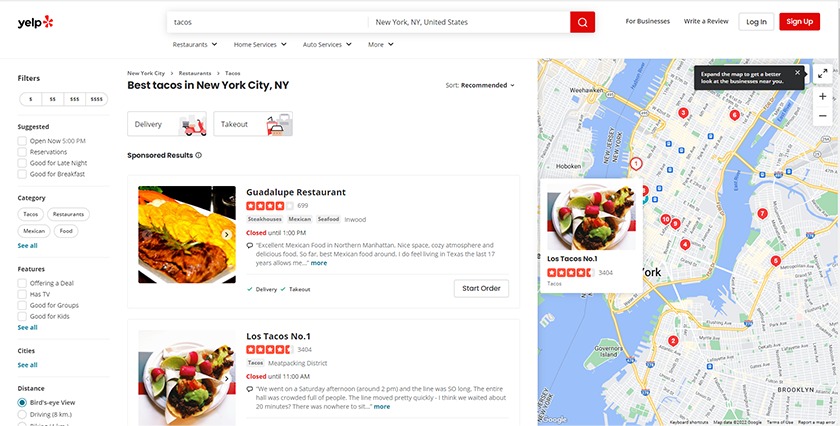
Online directories like Yelp or the Yellow Pages are a great (and no-cost) way to get found by your local community. (Source: Yelp)
Online business directories function like digital phone books. Plus, they help boost your online searchability. Because online directories also list your business’ relevant details, including your location, they also help you build online citations, ultimately improving your SEO.
They’re also usually completely free and easy to set up. You’ll only need to sign up for an account on your platform, fill in the important information about your business, and wait for your listing to be published. Business directories are also a trusted source for people looking for new businesses.
6. Set Up & Optimize Your Google Business Profile
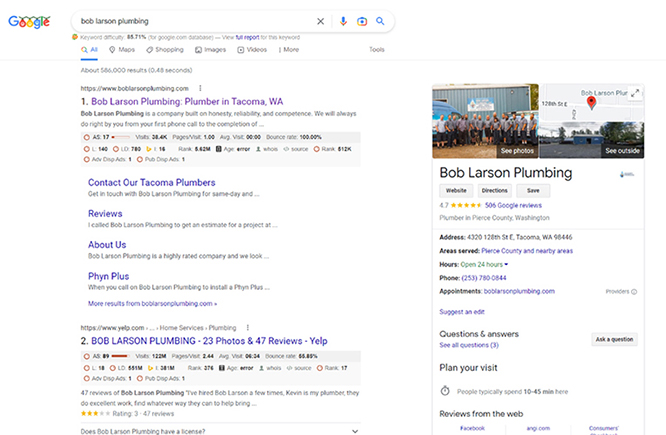
Setting up Google Business Profile is completely free and gets you on Google’s radar. (Source: Google)
If you only list in one online directory, make it Google Business Profiles. It’s one of the biggest in the world and it helps your business show up on relevant Google Search results, like in the example above. It’s especially helpful for getting discovered by people in your local area and for collecting reviews. Setting up a Google Business Profile is also free—you only need to verify that you have a business.
7. Curate a Strong Online Brand Identity
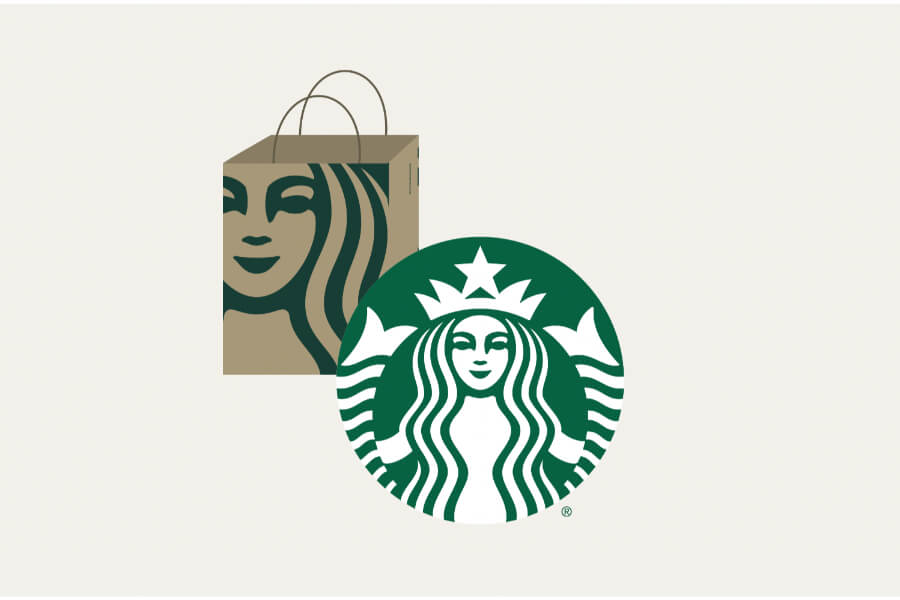
A strong brand identity helps your business be more recognizable, like this example from Starbucks.
When it comes to digital marketing for small businesses, crafting a memorable brand identity can open many doors. A visually interesting logo, for example, could cause a user to pause scrolling on their phone and visit your website, while branding consistency can increase revenue by up to 20%.
Many elements go into building a robust digital brand identity, starting with your logo and the colors on your website. Other aspects are your brand voice (e.g., friendly and approachable vs. formal and authoritative), design motifs, imagery, and even the fonts you use. Together, they form a visual identity for audiences to recognize your brand.
8. Refine Your Brand Positioning and Brand Story
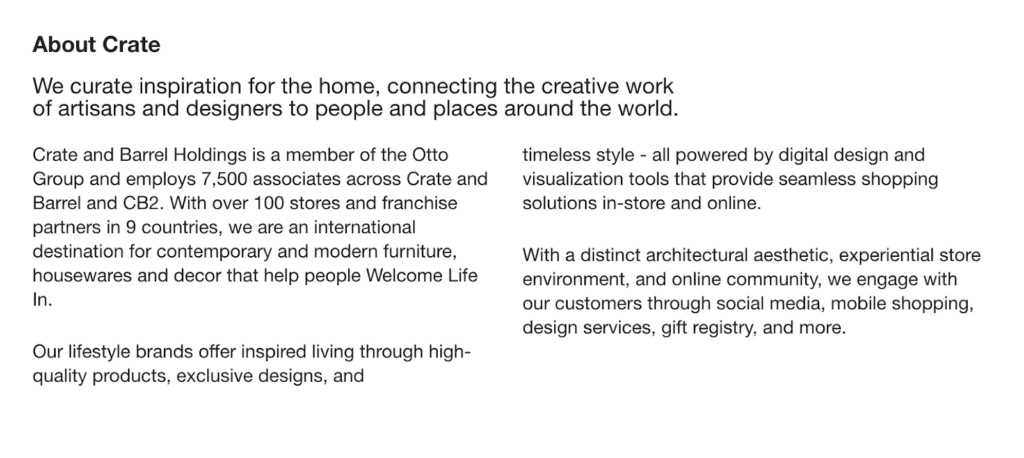
Crate & Barrel’s clear brand positioning helps it stand out among its competitors. (Source: Crate & Barrel)
Aside from your brand identity, the two other key parts of your branding are your brand positioning and brand story. These aren’t visual like your brand identity, but they can help you have a clearer picture of how your brand fits into the market and how it can reach your target audience more effectively.
Your brand positioning is simply a short statement about your brand’s primary objective, target audience, and the pain point it’s looking to address. A good example is Crate & Barrel’s statement. Writing your brand positioning out will help you better position your brand against your competitors.
Meanwhile, your brand story is like a “backstory” for your brand that presents your business as a solution to your audiences’ problems. It’s usually a few paragraphs long, identifying your audience’s pain points and then introducing how your brand can help. It acts as a reference point for all your marketing messages.
9. Focus Your Efforts on the Most Relevant Social Media Platforms
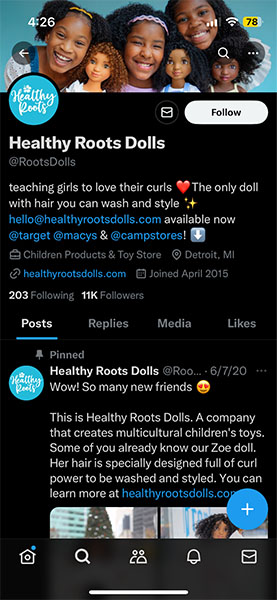
Different social media platforms have different ecosystems and audiences—find and leverage the ones that serve you best. (Source: @RootsDolls on X)
You already know that getting on social media is essential for your online presence. However, one of my biggest digital marketing tips for small businesses as a former social media manager is to focus only on the platforms where your audience is most active. You don’t need to be on Instagram, TikTok, and Facebook just because everyone else is. Maybe your audience is more active on Reddit or YouTube instead.
That said, you’ll need to do significant research and go through some trial-and-error before zeroing in on the platforms that serve you best. Ultimately, good social media marketing is all about fitting in with your audience naturally and talking and interacting with them instead of at them.
In my experience, creating a social media strategy takes as much work and research as crafting your overall marketing strategy. If you need extra help, I recommend hiring a social media marketing agency like Lyfe Marketing, which has a proven track record of growing small businesses on social media. It’s the best alternative if you don’t have the time to handle your social media yourself.
10. Send Press Releases for Important Announcements
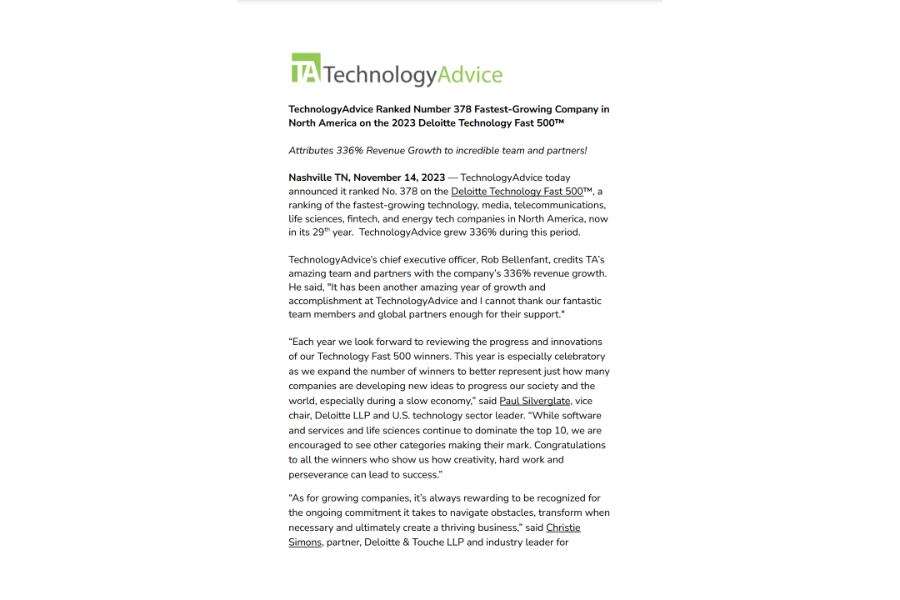
Press releases like these can introduce your brand to the wider public. (Source: TechnologyAdvice)
Press releases are one of the oldest strategies for growing your brand presence and credibility. They’re especially helpful for introducing your brand to the wider public, especially if you have an important announcement like a grand opening or product launch. And yes—even small businesses like yours can send press releases, as long as you follow the proper press release formatting and etiquette.
Also, make sure your press release story is relevant to journalists and their audience and is concise and easy to read. Lead with the most important info before following with supporting details. Finally, choose one of the best press release distribution services to target the media outlets you’re aiming for.
11. Create a Digital Press Kit for Journalists
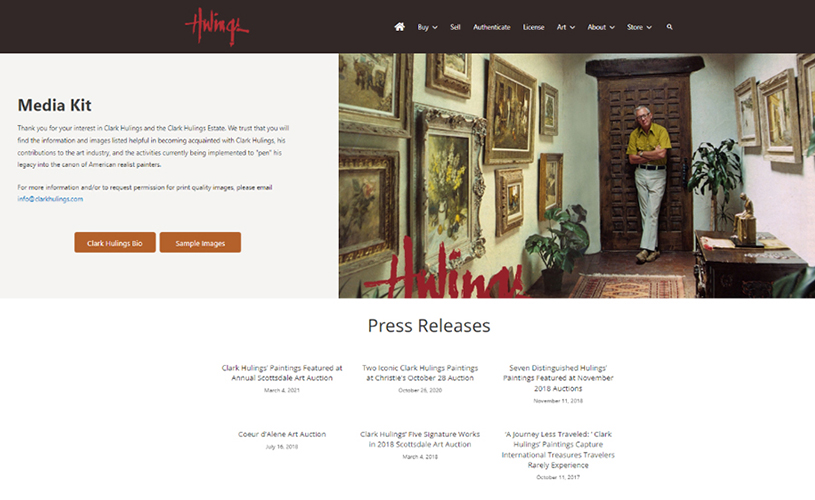
A digital press kit on your website like this makes it easy for journalists to get extra information about your business.
Like press releases, press kits are another way to help you earn press coverage. Your press kit usually contains basic information about your business like its location, target audience, stakeholders, and any major achievements or awards. It acts as a valuable resource for journalists if they’re covering your press release and need any extra information.
You can host your press release on a “Press” or “Media” page on your website so it’s easy to find. Aside from helping secure coverage, having a press kit also lets you shape your media narrative and how the public perceives your brand.
12. Leverage Influencers to Reach Niche Audiences

Influencers can help you reach niche audiences in authentic ways.
Growing a following on social channels can take a long time. However, digital marketing strategies like influencer marketing can supercharge your efforts. When done effectively, influencer marketing can be a cost-effective way to reach new audiences, especially if you’re in a more niche area, like, e-gaming or pet products. Influencers can help you tap into your target audience in an authentic, non-intrusive way.
You don’t even have to partner with big-time influencers with millions of followers. There are plenty of micro or nano influencers with a few thousand followers who charge much less per post and often have more intimate connections with their followers. And of course, choose influencers that best represent your brand identity.
13. Use Chatbots to Boost Website & Social Media Engagement
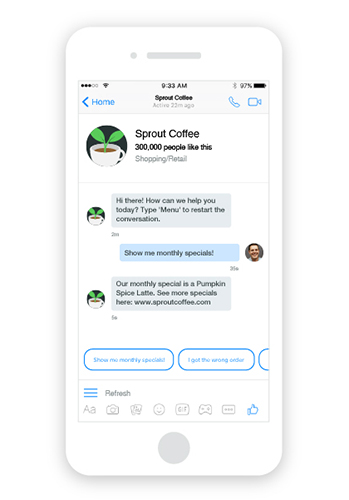
Chatbots can help keep your customers engaged on your website or social media page.
In a digital age, customers expect brands to answer their messages as quickly as possible. Doing so also keeps your followers engaged. And if you don’t have the human resources for that, an easy solution is to use chatbots that can automate responses for you.
Many messaging apps like Facebook Messenger have built-in chatbots, or you can also use a chatbot solution like LiveChat or Podium to add chatbots to your website. They can be particularly helpful if your business is very customer service-oriented or you don’t have the resources for a full customer service staff.
Tools like LiveChat let you easily add AI-powered chatbots to your website. It also has message templates you can use to set up your chats and chat engagement reports so you can measure the types of questions your site visitors are asking the most.
14. Hold Online Contests and Giveaways
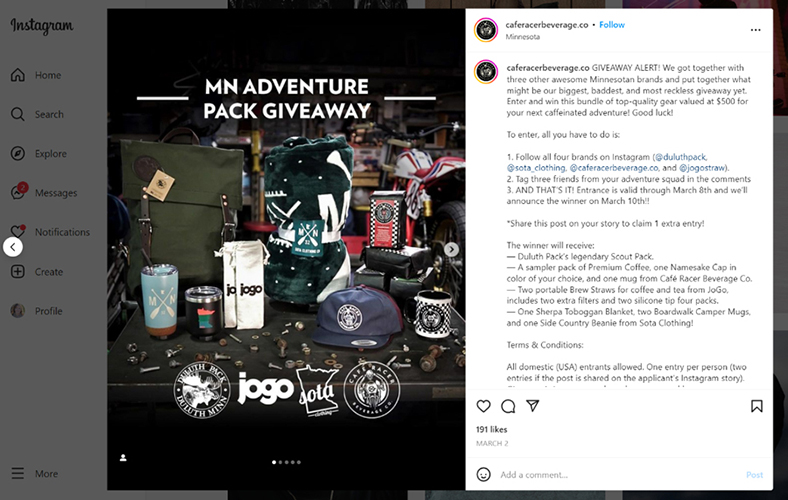
Social media contests and giveaways like this can easily boost user engagement.
Another way to quickly spark engagement on social media is by holding contests and giveaways that require engagement (such as following the brand, liking the post, sharing it, tagging someone, or adding a comment) as part of the contest’s mechanics. Other alternatives are photo contests or hashtag-based and trivia competitions.
When running contests on social platforms as part of digital marketing for small businesses, always keep within legal boundaries. For example, Facebook and X have guidelines for running contests on their platforms.
Give an extra contest entry to social media followers who sign up for email updates in addition to your regular contest mechanics. This will grow your list more quickly and allow you to engage with your community on more platforms. Email marketing software like HubSpot allows you to integrate your social media with your emails, making it easy for people to subscribe to your emails.
15. Collect & Display Positive Reviews to Boost Your Online Reputation
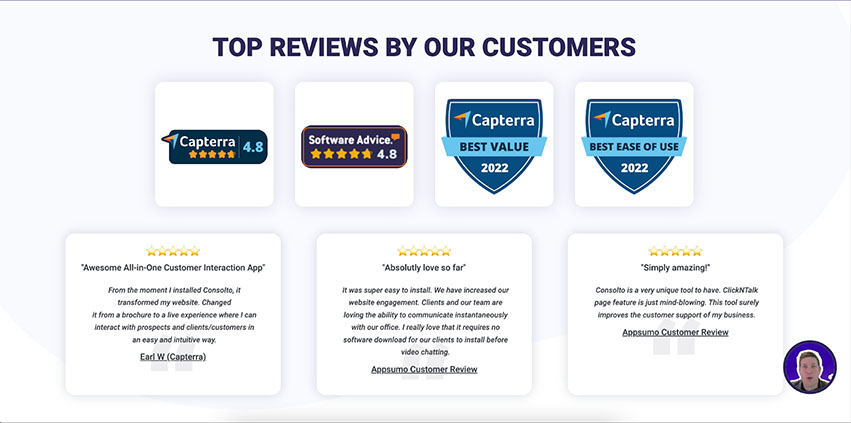
Collecting positive reviews like these can steadily build a positive reputation for your brand.
Managing your brand’s online reputation is a whole area of marketing within itself. The biggest part of it is monitoring and replying to your reviews on listing platforms like Google Business Profile and Yelp and making sure you continuously address negative comments.
However, it also involves collecting positive reviews so your business has a stellar reputation. A good way to do that is to request reviews from customers who’ve had positive experiences with your business. As long as you ask politely, most people don’t mind leaving good reviews to support small enterprises.
16. Feature Customer Testimonials as Social Proof

Testimonials act as social proof and increase your credibility, like this example on commerce business GoHenry’s website.
Customer testimonials can also be a powerful tool to convince people in the “consideration” stage to convert. Testimonials act as social proof, making your brand appear more authentic and credible to prospective customers. They can even lead them to take specific actions—sometimes even more so than any ad copy or call to action.
Some ways to highlight customer testimonials are by creating a testimonial page on your website, posting on social media (usually with a specific hashtag), or producing interview videos.
17. Leverage Video to Get Organic Engagement
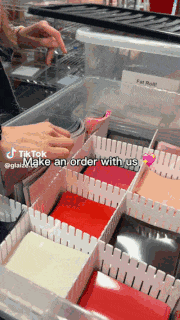
Authentic short-form videos like these are steadily taking over social media. (Source: @glaze.co via TikTok)
It’s no secret that video is one of today’s most effective marketing tools. When building your social media strategy, include video as part of your content strategy. Whether it’s an explainer video, an animated infographic, or interview testimonials, the possibilities for video are endless.
Because videos are more time and labor-intensive—and varied—make sure you plan your video marketing strategy. For example, you might do a demo video to accompany your product launch once every quarter, while you can do short-form vertical videos for your daily social media posts.
Creating videos—especially short-form ones for social media—in this day and age doesn’t require fancy equipment or special skills. Online video-editing tools like Animoto are beginner-friendly and inexpensive and have dozens of video templates to help you get started.
18. Go Live on Facebook or Instagram for Real-time Interactions
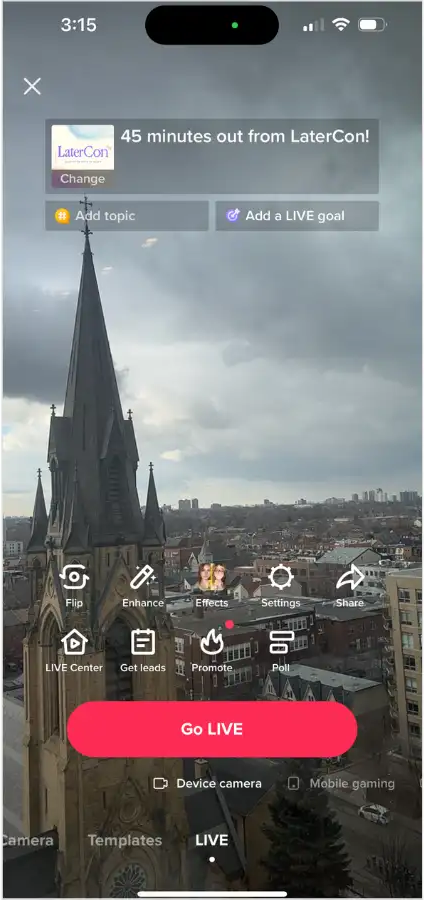
Live videos give you real-time user engagement and are easy to do on TikTok and Instagram.
Gone are the days when live broadcasts were limited to TV or radio, as tools like Facebook and Instagram Live allow anybody to broadcast live videos at any place and time. They’re effective for generating real-time engagement with followers and help showcase the human side of your business.
Primarily, what sets live videos apart from pre-made videos is their immediacy. Countless content ideas are possible with live broadcasts. Use them for product launch announcements, to interview notable personalities in your field, to host an impromptu tour of your facility, to demo a product, or to host tutorials or Q&A sessions—anything is possible, as long as they follow your business goals.
19. Send Email Newsletters to Keep Customers Engaged
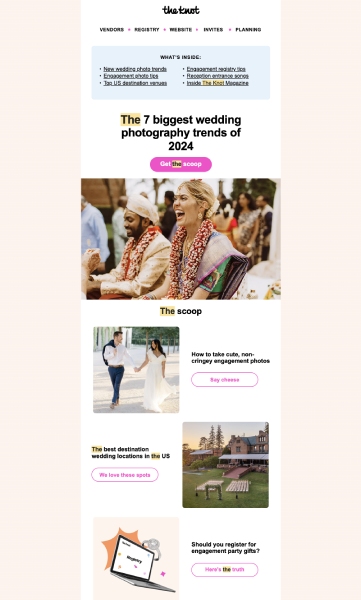
Newsletters are a great way to share lots of information about topics in your industry and keep current customers engaged with your business.
While social media and search rankings are valuable channels for reaching customers, permission-based email marketing can nurture relationships over the long term. For one, emails are a direct, personal, clutter-free way of communicating where your content isn’t competing with dozens of others on their screen. And since recipients actively opt-in to receive your emails, they’re more likely to take time to read them and take action.
Email newsletters are versatile, and the best ones are informative and engaging, with high-quality content that matters to the audience. When making a newsletter, combine several sections to keep it interesting and engaging. These can be helpful articles, images, infographics, videos, links to other valuable content. Keep each section short, with links back to your website to read more, shop online, book an appointment, or take some other desired action.
20. Send Prospecting Emails to Generate Leads
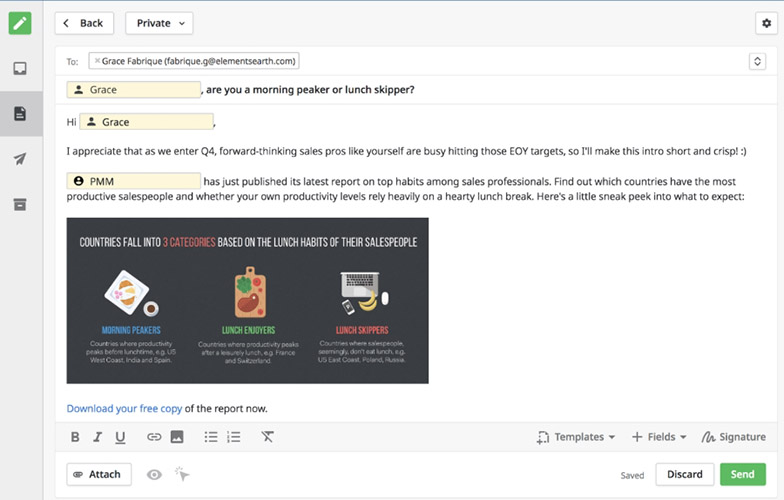
Good old cold emails are still an effective way to generate leads. (Source: Pipedrive)
Sometimes, marketing can be as straightforward as sending an email—not just mass emails to large contact lists, but good old one-on-one cold sales emails introducing yourself and your business and pitching your value proposition. While it may not be as flashy or cutting-edge as other forms of digital marketing, it’s stuck around for a reason: it’s effective. Cold emails can be especially effective for B2B marketing or product introduction.
21. Use Gated Content to Collect Leads
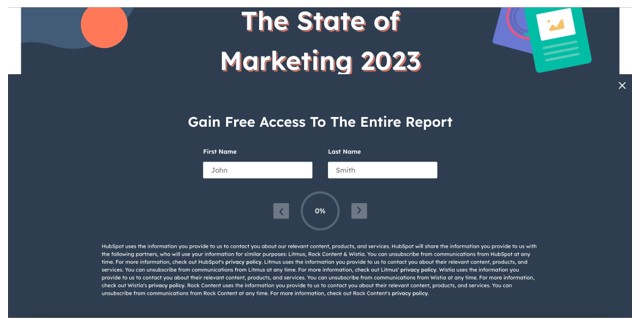
Keeping your most valuable content gated like in HubSpot’s example helps you generate leads. (Source: HubSpot)
Gated content is any type of content website visitors need to give their email address in exchange for access, like HubSpot’s report above. It can be anything from published studies and worksheets to ebooks, online courses, videos, tutorials, and webinars, tackling any relevant topics in your industry.
You can use gated content throughout the sales pipeline to build prospecting lists, nurture leads, or produce conversions. It can even become a revenue-producing product in and of itself. The key to making gated content work is ensuring it’s valuable and relevant enough for your readers to get them to provide their information in exchange.
22. Host Webinars to Interact With Live Audiences

Webinars are an opportunity to share valuable content with audiences in real time.
Webinars are an excellent venue to show yourself as an expert in your field while having real-time interactions with prospects. They’re much like in-person events, but far less costly as you only require good video conferencing software and a relevant topic. Plus, they’re effective for growing brand awareness, generating leads, and even converting leads into customers.
23. Design Good Landing Pages That Convert
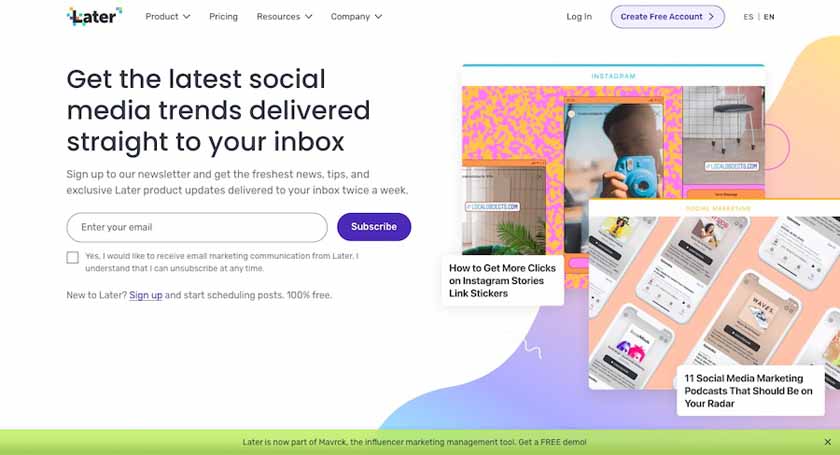
Good landing pages have meaningful design and an easy-to-follow call to action. (Source: Later)
Landing pages are dedicated pages on your website that users “land” on after clicking a specific link or following a call to action. Examples are newsletter signup forms or app download pages. A good landing page can significantly increase your conversions, so designing them well is crucial.
To design good landing pages, first identify their main objective. Is it to get people to sign up for a free trial? To use a coupon code? Each landing page should only have one objective. It’s what guides all your other landing page elements. Then, write punchy, effective copy and give an irresistible call to action that offers audiences value.
24. Promote Limited-time Offers to Encourage Sales

Leverage limited-time offers like these to encourage sales on your online store. (Source: Brooklinen)
Limited-time offers have long been an effective digital marketing strategy because they create a sense of urgency for customers. This is even more so in the digital age and can be especially helpful if you have an online store. Use limited-time offers to encourage more sales in a given period, for example during the holiday season or a new product launch.
Limited-time offers can be anything from a 25% discount to a free shipping voucher or a free gift, as long as they’re only available for a specific time. Promote them via emails, social media, or even directly on your website.
25. Use QR Codes to Connect to Digital Experiences
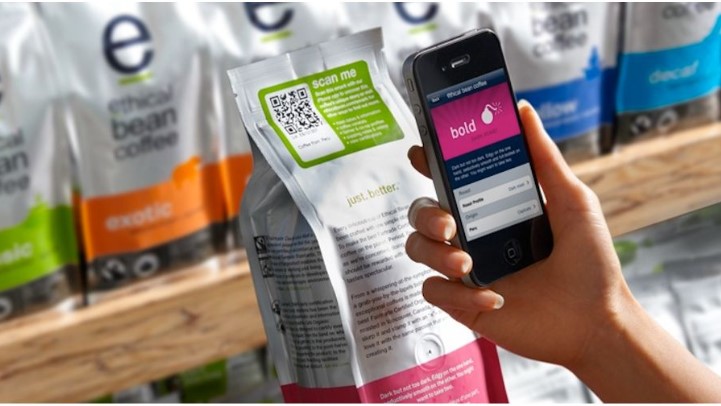
QR codes are a nifty way to connect your offline customers to online experiences. (Source: MSLK)
Traditionally, your digital experiences can only be accessed by people who are already online, for example, your social media followers or email subscribers. But QR codes can change all that. Short for “quick response” codes, QR codes can instantly bring people to specific landing pages and websites or any of your business’s online fronts.
In short, they’re a great way to connect your offline audiences with digital experiences and encourage them to be part of your online community. Add QR codes to your physical storefront, product packaging, or direct mail marketing collateral.
26. Run Google Search or Local Services Ads to Reach Your Local Community
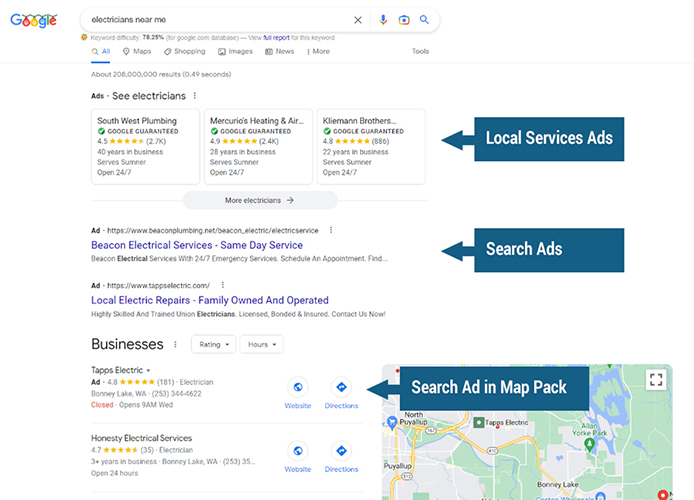
A screenshot showing Google Local Services Ads, search ads, and map ads in search results. (Source: Google)
Ranking in Google’s search engine results page (SERPs) organically can get you exposure and web traffic, including site visitors that become leads and customers, but it takes time. To generate leads on Google more quickly, use Google search display ads or Local Services Ads to put your brand on top of first-page search results.
Advertising on Google guarantees you a spot on top of Google’s search results page when users search for your chosen keywords. When someone clicks your ad, users are prompted to take specific actions (e.g., visiting your website or landing page or calling your business), immediately generating new high-quality leads from people who are ready to buy.
27. Advertise on Social Media to Boost Brand Awareness
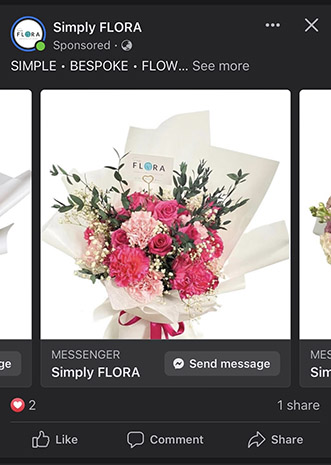
Social media ads like these can get your brand in front of wide, active audiences. (Source: Simply FLORA)
Like Google Ads, social media advertising offers budget-friendly targeted advertising opportunities for your small business. They’re a simple and cost-effective way of getting your brand in front of thousands of audiences.
To start, identify the social platforms where you’ll run your ads and the type of ads you’ll run (single images, carousels, videos, and so on). Then, decide on your ad objective and ad budget, create your ad concept, and launch and track your ads. Use your insights to create more effective ads in the future.
28. Launch a Digital Loyalty Program to Keep Customers Coming Back

Digital loyalty programs like this one from retail brand Blume encourage customers to interact with your brand more often. (Source: Blume)
Loyalty programs are an excellent strategy for customer retention and can influence consumers to keep coming back and spend more time and money with your brand. You may have seen them before with Starbucks’s Rewards Program or Nordstrom’s Nordy Club.
But loyalty programs can also go digital. They’re usually accessed through your website or even through smartphone apps. And they offer even more opportunities for your people to take action and earn points, like watching a specific video or writing a review.
29. Look Into Affiliate Marketing and Brand Ambassadors

Makeup brand Sephora has one of the best examples of successful brand ambassador programs. (Source: Sephora)
Aside from loyalty programs and influencer marketing, affiliate marketing, sometimes known as brand ambassador programs, is one of the most up-and-coming digital marketing business ideas to reach new audiences. Brand ambassadors are similar to influencers, except they have more freedom with their content and earn a small commission with each sale they make. A good example is Sephora’s #SephoraSquad Program, pictured above.
Brand ambassadorships work by leveraging your customers’ social circles. However, they’re only effective when your brand is already well-known in your area, not when it’s relatively new.
Why Digital Marketing Is Important for Small Businesses
Digital marketing is important for small businesses for one primary reason: we live in a digital-first world. And it’s a world that continues to grow every day. In today’s business landscape, getting your business noticed means getting it on online platforms like search engines and social media—especially with eight in 10 US consumers searching online for local businesses at least once a week.
That means not getting your business an online presence risks losing a lot of potential customers. Digital marketing also gives you more avenues for customer engagement; for example, social media, email marketing, and even through online reviews. It’s also easier to track than traditional marketing because it has precise metrics (like click and conversion rates) and is often more cost-effective.
Frequently Asked Questions
Small businesses can use digital marketing to grow their online presence by building a website (and optimizing it), getting on social media, starting content marketing, and building a positive reputation through good reviews. Businesses can also build customer retention through email marketing and creating an online community. They can also increase sales by leveraging digital ads and offering limited-time offers. Loyalty programs can also foster brand loyalty.
Digital marketing can cost nothing more than your time and effort for strategies like content marketing, organic social media, and reviews management. It’s also free to build a website on platforms like Wix and Weebly, although you’ll need to pay a small annual fee to use your own domain. You’ll also need to pay for digital ads, although you can set your own budget. Meanwhile, hiring a digital marketing agency can cost anywhere from $150 to more than $10,000.
Yes, of course, you can do digital marketing for your business by yourself. The best place to get started is by building your website through free and user-friendly platforms like Wix and Weebly. Then, continue building your online presence by creating social media profiles, listing on online directories like Google Business Profile and Yelp, and starting content marketing like publishing blogs and email newsletters.
Bottom Line
The online world has opened up countless opportunities for marketing your business and reaching audiences both locally and internationally. The digital marketing tips for small businesses above are proof of that and are the best ways to get started. They cover everything from building your brand awareness to driving sales and fostering brand loyalty. And most of them don’t require a heavy budget or years of skilled experience.